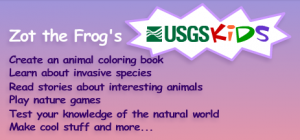For more information go to http://education.usgs.gov/
Communicating results of scientific research to multiple audiences is a critical component of the geographer’s work. Public opinion on important scientific matters such as climate change and evolution may be highly affected by political battles, and effective communication of scientific information is necessary. The USGS Education website tries to tackle this challenge by sharing videos, animations, lectures, maps, and diagrams explaining a range of topics from the water cycle to volcanic ash.
USGS Education contains three primary sections: Primary Education, Secondary Education, and Undergraduate Education. Geography topics in the website include geomagnetism, plate tectonics, rocks, Earth history, earthquakes, wildfires, and more. For children in primary school grades, USGS has made public a series of activities, games, coloring pages, and stories that teach them about animals, wild birds, climate change, and bee population declines. Kids may also sign up with their class to be volunteers and monitor plants and animal species found across the US. For the older kids and teenagers, podcasts, tables, diagrams of the scientific process, and simple raw data are available in the website. Students are able to post their questions and USGS scientists may answer their questions in a series of brief videos. Publications “written for the general public” and “simple explanations” are available too.
For those completing their undergraduate studies, USGS has published online seminars, research on invasive species, raw data, reports, maps, and debates on climate change. Online lectures recorded at USGS facilities are also available and they include topics on the atmosphere & weather, biology & ecosystems, climate change, coastal and marine science, earthquakes, geology, human health, mapping and remote sensing, and more. Essentially, everything you may need for your final and beyond.
Throughout the semester we used USGS data to explore floods and streamflow levels. We produced some interesting reports but, in practice, our work would probably not generate much response from a general audience. The USGS Education site is a great resource to communicate many of these crucial findings to large and diverse audiences.



I strongly agree that, for Geography-minded scholars, communicating your results is crucial for constructive and productive discussion. Additionally, alerting the younger generations about current geographic trends will better prepare our society for issues including water depletion and climate change. If I was still in middle school trying to ace an Earth Science test, I would certainly use this tool.
I think website is a really awesome resource for the public to understand what is going on with global climate change. So many studies and news reports are presented in a way that make it difficult for people to understand, if they are not familiar with the technology, and they lose interest and stop paying attention. It’s great that USGS is engaging kids at a young age so they are aware of what is happening in the world around them, because these are the people who it will affect the most. I agree that nothing is going to change unless people are aware, and in order to have the sense of urgency necessary for progress the public needs to understand. This is website is accessible for many ages and education levels, and it seems like an important tool.